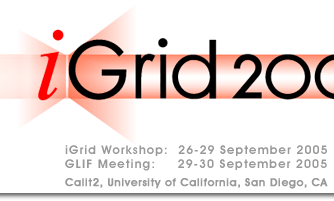iGrid to Present Highest-End International Technology and Application Demonstrations
San Diego, CA, August 23, 2005 - The biennial iGrid workshop, becoming known as the Woodstock of Networking, will provide a few-day peek into the networked world of the future less than five weeks from now. iGrids primary focus is to demonstrate state-of-the-art use of international optical networks showcasing the highest-performance scientific and technology capabilities. It will include keynote presentations, panels, and master classes. And it will be the first major event hosted at the new Calit2 building at UCSD.
Attendance grows significantly each time this event is held. Some 400 people representing 20 countries from Europe, North America, South America, and the Pacific Rim are expected to participate during the five-day event, starting September 26. (The workshop can still accommodate more participants; to register, go to www.igrid2005.org.)
Watch this website for an iGrid blog: Concurrent with iGrid, Calit2 intends to launch a new blogosphere to share a variety of perspectives on the event through video, audio, and written media from Calit2 communications professionals Doug Ramsey and Stephanie Sides; Lev Manovich, one of todays most influential thinkers in the fields of media arts / digital culture and a professor in the UCSD Visual Arts department; and hopefully some of the iGrid demonstrators themselves.
iGrid keynote presentations will be made by José Muñoz, NSF; Larry Smarr, Calit2 director; Carter Bullard, QoSient LLC; Bill St. Arnaud, CANARIE; and Ian Foster, Argonne National Lab and University of Chicago.
iGrid panels will address both technical and more general-interest topics. Master classes will be taught on optical control planes, service-oriented infrastructure, and the User Controlled LightPath software.
Nearly 50 demos will be presented at iGrid, many of which will be reprised at SC05 (Supercomputing), which takes place November 12-18 in Seattle, WA.
The demonstrations will represent a range of disciplinary areas, including design / art, gaming, cultural heritage, chemistry, physics (broadly construed to include astronomy and planetary science), environmental / earth science, and biology / medical / neuroscience.
Most of the demonstrations can be categorized roughly into these technology classifications (with many fitting more than one):
- Remote control of capabilities (instrumentation, computational simulations, etc.)
- High-definition applications
- Interactive applications
- Multicast applications
- Collaborative environments
- Visualization
- Manipulation and transfer of extreme amounts of data
- New technical capabilities at the network level
Subsequent articles in this space will briefly describe the demos in each category. These articles will be published weekly leading up to the event.


